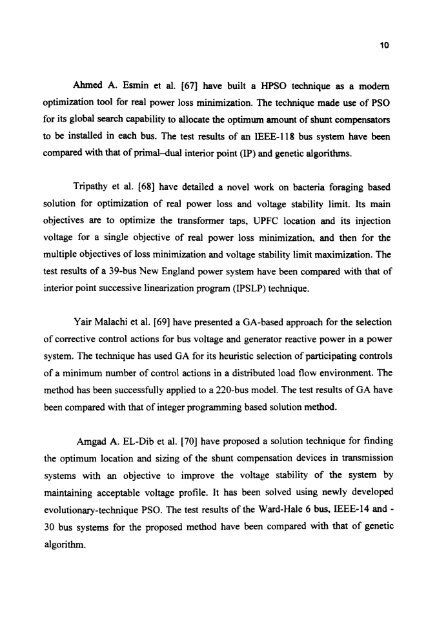performance evaluation of swarm intelligence based power system ...
performance evaluation of swarm intelligence based power system ...
performance evaluation of swarm intelligence based power system ...
Create successful ePaper yourself
Turn your PDF publications into a flip-book with our unique Google optimized e-Paper software.
Ahmed A. Esmin et al. [67] have built a HPSO technique as a modemoptimization tool for real <strong>power</strong> loss minimization. The technique made use <strong>of</strong> PSOfor its global search capability to allocate the optimum amount <strong>of</strong> shunt compensatorsto be installed in each bus. The test results <strong>of</strong> an IEEE-I 18 bus <strong>system</strong> have beencompared with that <strong>of</strong> primal4ual interior point (IP) and genetic algorithms.Tripathy et al. [68] have detailed a novel work on bacteria foraging <strong>based</strong>solution for optimization <strong>of</strong> real <strong>power</strong> loss and voltage stability limit. Its mainobjectives are to optimize the transformer taps, UPFC location and its injectionvoltage for a single objective <strong>of</strong> real <strong>power</strong> loss minimization, and then for themultiple objectives <strong>of</strong> loss minimization and voltage stability limit maximization. Thetest results <strong>of</strong> a 39-bus New England <strong>power</strong> <strong>system</strong> have been compared with that <strong>of</strong>interior point successive linearization program (IPSLP) technique.Yair Malachi et al. 1691 have presented a GA-<strong>based</strong> approach for the selection<strong>of</strong> corrective control actions for bus voltage and generator reactive <strong>power</strong> in a <strong>power</strong><strong>system</strong>. The technique has used GA for its heuristic selection <strong>of</strong> participating controls<strong>of</strong> a minimum number <strong>of</strong> control actions in a distributed load flow environment. Themethod has been successfully applied to a 220-bus model. The test results <strong>of</strong> GA havebeen compared with that <strong>of</strong> integer programming <strong>based</strong> solution method.Amgad A. EL-Dib et al. [70] have proposed a solution technique for findingthe optimum location and sizing <strong>of</strong> the shunt compensation devices in transmission<strong>system</strong>s with an objective to improve the voltage stability <strong>of</strong> the <strong>system</strong> bymaintaining acceptable voltage pr<strong>of</strong>ile. It has heen solved using newly developedevolutionary-technique PSO. The test results <strong>of</strong> the Ward-Hale 6 bus, IEEE-14 and -30 bus <strong>system</strong>s for the proposed method have been compared with that <strong>of</strong> geneticalgorithm.
















